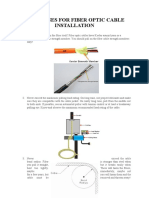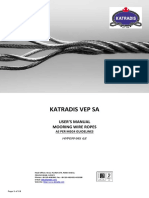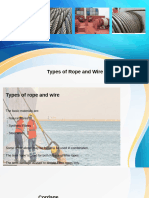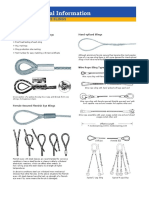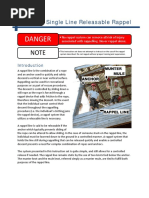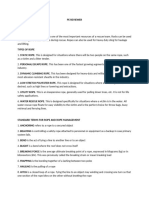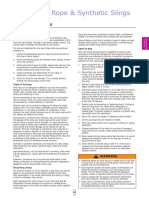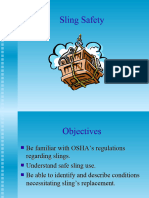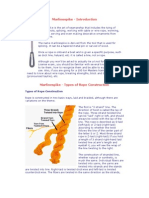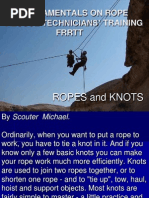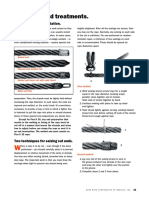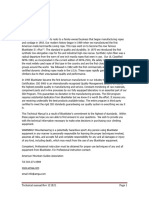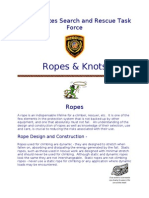Greenlee cable-pulling-safety
Greenlee cable-pulling-safety
Uploaded by
loganjtomkoCopyright:
Available Formats
Greenlee cable-pulling-safety
Greenlee cable-pulling-safety
Uploaded by
loganjtomkoCopyright
Available Formats
Share this document
Did you find this document useful?
Is this content inappropriate?
Copyright:
Available Formats
Greenlee cable-pulling-safety
Greenlee cable-pulling-safety
Uploaded by
loganjtomkoCopyright:
Available Formats
VOLUME 1, AUGUST 2005
MA-4730, ©2005 Greenlee Textron Inc.
Greenlee Textron Inc. is a subsidiary of Textron Inc.
CABLE PULLING
ROPE SAFETY
Rope is a very critical link in the cable pulling
system. Using the wrong type of rope, using
rope with the wrong breaking strength, or using
damaged rope can result in the rope breaking
during a cable pull. When this happens, a great
deal of energy is released. This release of energy
can cause injuries and damage.
Greenlee recommends that the following steps
should be observed in the selection and use of cable pulling rope.
1. Select a rope with an average breaking strength at least four times the rated capacity of your puller (rope
safety factor). A safety factor of 4:1 or greater is REQUIRED for pulling inside of raceways and conduit when
a minimum of rope length will be exposed. Higher safety factors are recommended if the pulling rope is
exposed! These safety factors are for new rope in good condition without kinks or splices.
2. Use only low stretch double-braided polyester for high force cable pulling. High stretch ropes store
energy much like a stretched rubber band. If, for any reason, there is a failure of the rope, pulling grip,
conductors, or any other component in the pulling system, this “stored-up” energy will suddenly be
unleashed. The whipping action of a rope can cause considerable damage, serious injury or death.
3. When pulling, avoid sharp corners, edges, wedging or dragging over rough ground. Dirt and grit picked up by
the rope can work into the strands reducing its pulling capacity. If there is any question, discard a used rope.
4. Inspect rope thoroughly before using it to make a cable pull. Make sure there are no cuts or frays in the rope.
Remember, the rope is only as strong as its weakest point. INSPECT THOROUGHLY BEFORE USING!
5. When designing the pull, keep rope confined in conduit wherever possible. Should the rope break, or
any other part of the pulling system fail, releasing the stored energy in the rope, the confinement in the
conduit will work against the whipping action of the rope by playing out much of this energy within
the conduit.
6. Do not permit anyone to stand in a direct line with the pulling rope. If any part of the pulling system
should break during a pull, the most dangerous area is directly in line with the pulling rope.
ALWAYS FOLLOW SAFE PRACTICES
You might also like
- Basic RopemanshipDocument29 pagesBasic RopemanshipMotmot DualloNo ratings yet
- The Useful Knots Book: How to Tie the 25+ Most Practical Rope Knots: Escape, Evasion, and SurvivalFrom EverandThe Useful Knots Book: How to Tie the 25+ Most Practical Rope Knots: Escape, Evasion, and SurvivalRating: 5 out of 5 stars5/5 (1)
- Use and Care of Wire RopeDocument8 pagesUse and Care of Wire RopeAnonymous 7fsk6ZFMNo ratings yet
- Rigging KNOTSDocument13 pagesRigging KNOTSDexter Fernandez100% (1)
- Guidelines For Fiber Optic Cable InstallationDocument14 pagesGuidelines For Fiber Optic Cable InstallationBrielle ManuelNo ratings yet
- Military MountaineeringDocument21 pagesMilitary MountaineeringSean Ben Kadusale100% (1)
- Fiber Rope and Wire RopeDocument20 pagesFiber Rope and Wire RopeGabrielNo ratings yet
- Use and CareDocument4 pagesUse and CarechannarongNo ratings yet
- Wire RopeDocument4 pagesWire RopedobricovekNo ratings yet
- E 45 GP 005 - Installation of Belts On ConveyorsDocument11 pagesE 45 GP 005 - Installation of Belts On Conveyorsthiru_jsrNo ratings yet
- User S Manual Wire RopesDocument13 pagesUser S Manual Wire RopesRajesh NairNo ratings yet
- Care of Belting Rev 01Document10 pagesCare of Belting Rev 01jonodo89No ratings yet
- important points on wires and ropes - копияDocument2 pagesimportant points on wires and ropes - копияВлад РайлиNo ratings yet
- Materials Handling: in ConstructionDocument41 pagesMaterials Handling: in ConstructionSatya NaiduNo ratings yet
- Proper Wire Rope UseDocument10 pagesProper Wire Rope Usekartoon_38No ratings yet
- Week-4 PPTDocument29 pagesWeek-4 PPTDilbert BatingaNo ratings yet
- Crane and Lifting SafetyDocument41 pagesCrane and Lifting SafetySarferi AbdullahNo ratings yet
- General Information: Wire Rope SlingsDocument7 pagesGeneral Information: Wire Rope Slingsegy pureNo ratings yet
- Mechanical Lifting SafetyDocument19 pagesMechanical Lifting SafetyHse GroupNo ratings yet
- Instruction Set Draft Final Axb1046Document7 pagesInstruction Set Draft Final Axb1046api-326132757No ratings yet
- Correct Usage Instructions For Lifting EquipmentDocument6 pagesCorrect Usage Instructions For Lifting Equipmentmiraç burak navruzNo ratings yet
- Hoisting & RiggingDocument5 pagesHoisting & RiggingRam SinghNo ratings yet
- Truco Belting CareDocument5 pagesTruco Belting Carejonodo89No ratings yet
- Super Slings Rigging Catalog 2020 - 1D Slings Wire Rope 1001 - WebDocument30 pagesSuper Slings Rigging Catalog 2020 - 1D Slings Wire Rope 1001 - WebDouglasFariaNo ratings yet
- Pe ReviewerDocument9 pagesPe ReviewerprincessmaecanoogNo ratings yet
- Wire Rope Technical InfoDocument11 pagesWire Rope Technical Infoأزيزى سودينNo ratings yet
- Care in Use Wire Rope SlingsDocument1 pageCare in Use Wire Rope SlingsEhsan Bahrami Gol SorkhdanNo ratings yet
- Basic Technical Winch InformationDocument7 pagesBasic Technical Winch InformationMarcos GonzalezNo ratings yet
- Safe Slinging PracticeDocument78 pagesSafe Slinging Practiceanurag_4013100% (2)
- Sling SafetyDocument17 pagesSling Safetymichol2014No ratings yet
- Basic RopesmanshipDocument4 pagesBasic Ropesmanshipdevilluke1122No ratings yet
- Marlinespike - Introduction: Types of Rope ConstructionDocument23 pagesMarlinespike - Introduction: Types of Rope Constructiondavidantis100% (1)
- Care Maint. StrengthDocument8 pagesCare Maint. StrengthMitanshu ChadhaNo ratings yet
- Instructions For The Use of WirelockDocument6 pagesInstructions For The Use of WirelockLeo MottaNo ratings yet
- Basic Ropes and KnotsDocument31 pagesBasic Ropes and KnotsSuralta Eenah100% (1)
- Wire Rope End Treatments.: Preparation For InstallationDocument10 pagesWire Rope End Treatments.: Preparation For Installationegy pureNo ratings yet
- Accidents During Mooring OperationsDocument7 pagesAccidents During Mooring OperationsCristel_DCNo ratings yet
- Ropes and WiresDocument4 pagesRopes and WiresbernardinodinoNo ratings yet
- BR - Lifting Sling Inspection Criteria - R2Document2 pagesBR - Lifting Sling Inspection Criteria - R2Juan Alberto Lopez SanchezNo ratings yet
- Technical Manual Rev 121021Document20 pagesTechnical Manual Rev 121021José Alberto Garcia CordovaNo ratings yet
- Ropes and KnotsDocument17 pagesRopes and KnotsraxXEBEDENo ratings yet
- Katradis Vep Sa: User'S Manual Wire RopesDocument17 pagesKatradis Vep Sa: User'S Manual Wire RopesseawizeNo ratings yet
- Knots: An Illustrated Practical Guide to the Essential Knot Types and their UsesFrom EverandKnots: An Illustrated Practical Guide to the Essential Knot Types and their UsesNo ratings yet
- Mon TazaDocument7 pagesMon TazapipilipipiNo ratings yet
- 01 Guidelines For Fiber Optic Cable InstDocument14 pages01 Guidelines For Fiber Optic Cable InstAdrián NavarroNo ratings yet
- Rescue Knots and LinesDocument36 pagesRescue Knots and LinesBFP PANGLAONo ratings yet
- Care of Belting 02Document9 pagesCare of Belting 02jonodo89No ratings yet
- 101 Guidelines For Fiber Optic Cable InstallationDocument13 pages101 Guidelines For Fiber Optic Cable Installationarseniopm2013No ratings yet
- U2l5s Lifting ToolsDocument38 pagesU2l5s Lifting ToolspmcisissengueNo ratings yet
- 02 Wire Rope StrandDocument39 pages02 Wire Rope Strandmanuelperezz2567% (3)
- Mooring & Wire RopesDocument14 pagesMooring & Wire RopesAlex100% (2)
- Summary of RiggingDocument7 pagesSummary of RiggingMahmoud Abdallah100% (1)
- A Guide to the Use of Climbing Rope - A Collection of Historical Mountaineering Articles on Rope TechniqueFrom EverandA Guide to the Use of Climbing Rope - A Collection of Historical Mountaineering Articles on Rope TechniqueNo ratings yet
- The Knot Book - Knots, Bends and Hitches - A Guide for Sailors, Adventurers and HobbyistsFrom EverandThe Knot Book - Knots, Bends and Hitches - A Guide for Sailors, Adventurers and HobbyistsNo ratings yet
- Illustrated Seamanship: Ropes & Ropework, Boat Handling & AnchoringFrom EverandIllustrated Seamanship: Ropes & Ropework, Boat Handling & AnchoringNo ratings yet
- Net Making Made Simple - A Guide to Making Nets for Sport and HomeFrom EverandNet Making Made Simple - A Guide to Making Nets for Sport and HomeNo ratings yet
- Understanding Your Boats Systems and Choices.From EverandUnderstanding Your Boats Systems and Choices.Rating: 4 out of 5 stars4/5 (2)




